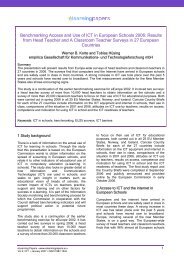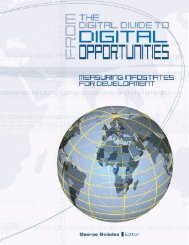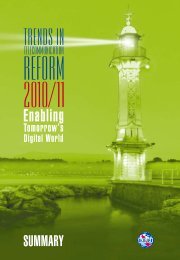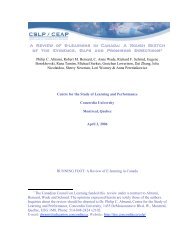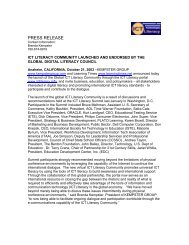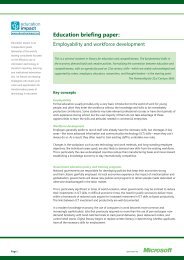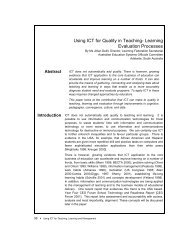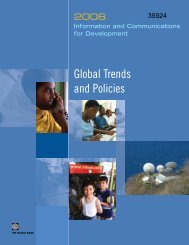The Digital Opportunity Index (DOI) - ITU
The Digital Opportunity Index (DOI) - ITU
The Digital Opportunity Index (DOI) - ITU
Create successful ePaper yourself
Turn your PDF publications into a flip-book with our unique Google optimized e-Paper software.
Statistical Chapter Three Annex<br />
Figure 3.8: Internet access, at home and elsewhere, in Mexico<br />
Proportion of homes with Internet connection,<br />
2002-2006<br />
Distribution of Internet users by location of use,<br />
2002-2006<br />
100<br />
6.1<br />
7.4<br />
8.7 9.0<br />
10.1<br />
80<br />
60<br />
40<br />
54.7 63.5 61.5 68.3 66.4<br />
20<br />
2002<br />
2003<br />
2004<br />
2005<br />
2006<br />
0<br />
2002<br />
2003<br />
2004<br />
2005<br />
2006<br />
Home<br />
Outside the home<br />
Source: Adapted from INEGI.<br />
In Latin America, Brazil and Mexico had the same<br />
household computer penetration of 18 per cent<br />
in 2005, yet in Brazil, 74 per cent of computers<br />
were connected to the Internet. In Mexico, only<br />
9.4 per cent of homes had Internet access. In<br />
terms of affordability, Mexico’s per capita income<br />
is twice as large as in Brazil and Internet costs consume<br />
a smaller proportion of income in Mexico.<br />
Furthermore, the home Internet penetration rate<br />
in Mexico grew only very slowly from 2002-2006<br />
(Figure 3.8). Further, most new Internet users in<br />
Mexico access the Internet from outside the home.<br />
While home and outside-home use was roughly<br />
equal in 2001, two-thirds of all Mexican Internet<br />
users now access the Internet from public facilities<br />
(i.e., Internet cafes and schools). Mexico has<br />
flat-rate local call pricing, whereas in Brazil, local<br />
calls are charged on a timed usage basis. From<br />
an economic perspective, there should be more<br />
Mexican households connected to the Internet<br />
Figure 3.9: Growth of broadband<br />
Number of economies with commercial broadband<br />
at speeds of 256 kbit/s or more, 2002-March 2007<br />
Growth in maximum broadband speeds in Africa,<br />
2003-2006<br />
81<br />
113<br />
133<br />
145<br />
166 170<br />
Number of countries<br />
12<br />
10<br />
8<br />
6<br />
4<br />
2<br />
2005<br />
2006<br />
2003<br />
2004<br />
2005<br />
2006<br />
2002 2003 2004 2005 2006 start<br />
2007<br />
0<br />
256<br />
512<br />
1'024<br />
2'048<br />
4'096<br />
Speed (kbps)<br />
Note (right chart): Maximum advertised broadband speeds may not be always available, depending on network congestion,<br />
latency, routing of data etc.<br />
Source: <strong>ITU</strong>/UNCTAD/KADO <strong>Digital</strong> <strong>Opportunity</strong> Platform.<br />
50



